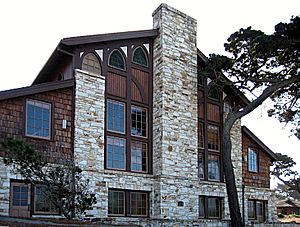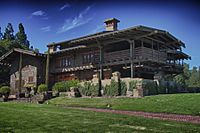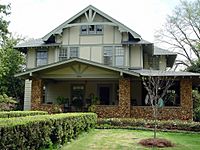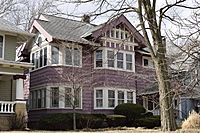American Craftsman facts for kids

An American Craftsman-style bungalow in San Diego, typical in older neighborhoods of many Western and Upper Midwest American cities
|
|
| Years active | 1890s–1930s |
|---|---|
| Influences | Arts and Crafts movement |
American Craftsman is a popular American style of homes and buildings. It was inspired by the British Arts and Crafts movement. This style also included how homes were decorated inside, how gardens looked, and even everyday art. It became popular in the late 1800s.
Before it, there was the Shingle style, which started making homes simpler. The Prairie style by Frank Lloyd Wright also influenced it. The name "Craftsman" came from Gustav Stickley, who made furniture. His magazine, The Craftsman, started in 1901. This style was very popular for smaller homes in Southern California around 1905. That's why smaller Craftsman homes are sometimes called "California bungalows." The style stayed popular until the 1930s. People still love and restore these homes today!
Contents
What Inspired the Craftsman Style?
The American Craftsman style grew out of the British Arts and Crafts movement. This movement started in the 1860s.
Why the Arts and Crafts Movement Started
The British Arts and Crafts movement was a reaction to the Industrial Revolution. During this time, machines made many goods quickly. This made things less special and often not as well made. People also felt that human work was not valued as much. The movement wanted to bring back the idea of skilled handwork. They believed that making beautiful, simple things by hand was important.
Thinkers like John Ruskin and William Morris were very important to this movement. They wanted to improve the lives of factory workers. They also wanted to show that crafts, like making furniture or pottery, were just as important as "fine art."
American Craftsman's Unique Twist
In America, the Craftsman style also reacted to the "over-decorated" look of Victorian homes. American designers shared many goals with the British movement. They wanted:
- Social improvements.
- A return to simple, traditional designs.
- To use natural materials found nearby.
- To celebrate handmade items.
However, American designers were also good at business. They found ways to make handcrafted items for the growing middle class. Gustav Stickley was key in this. He wanted to create nice, simple homes for everyday American families. This idea led to the popular Craftsman Bungalow style.
Craftsman homes often had strong, clean lines and natural materials. The name "American Craftsman" came from Gustav Stickley's magazine, The Craftsman. It showed designs for houses and furniture. These designs were influenced by American styles like Shaker furniture and the Mission Revival Style. They also took ideas from the Anglo-Japanese style. The focus on the artist's unique work later influenced the Art Deco movement of the 1930s. Even famous architect Frank Lloyd Wright was inspired by this style. He became a leader in the Prairie School of architecture.
-
The Gamble House, a famous American Arts and Crafts home by Greene & Greene in Pasadena, California, built 1908–1909
-
The Castle in the Clouds in New Hampshire, built 1913–1914
-
The Edward Schulmerich House in Hillsboro, Oregon, completed in 1915
-
The Abernathy-Shaw House in Talladega, Alabama, built in 1908
-
F.E. Cottrell Apartment Building in Toledo, Ohio, built 1914–1915
Famous Craftsman Designers

In Southern California, the firm Greene and Greene was very famous for their Craftsman designs. They designed beautiful homes like the Gamble House and the Robert R. Blacker House in Pasadena. They also designed the Thorsen House in Berkeley, California. Other examples in the Los Angeles area include the Lummis House by Theodore Eisen and Sumner P. Hunt.
In Northern California, architects like Bernard Maybeck and Julia Morgan were known for their detailed Craftsman projects. Julia Morgan designed the Asilomar Conference Grounds and buildings at Mills College.
In San Diego, California, the style was also very popular. Architect David Owen Dryden designed many Craftsman California bungalows. The Marston House in Balboa Park was designed by Irving Gill and William Hebbard in 1905.
In the early 1900s, a developer named Herberg J. Hapgood built many Craftsman-style homes in Mountain Lakes, New Jersey. These homes were often made of stucco. They included bungalows and chalets.
The Castle in the Clouds in New Hampshire is another example of the American Craftsman style. It was built in 1913–1914 for Thomas Gustave Plant by architect J. Williams Beal.
What Do Craftsman Homes Look Like?
Craftsman homes have some special features that make them easy to spot:
- They usually have low, gently sloped roofs. These are often gabled (like an upside-down V) or sometimes hipped (sloping on all sides).
- The roof edges often stick out far past the walls, creating deep overhangs.
- You might see exposed wooden rafters or decorative brackets under the roof edges.
- They often have a wide front porch. This porch is usually under an extension of the main roof.
- The porch roof is often held up by thick, square columns that get narrower at the top.
- Windows are typically double-hung with a pattern like 4 panes over 1 large pane, or 6 over 1.
- Roofs and sometimes walls are covered with shingles.
- They feature beautiful hand-crafted stone or woodwork.
- They often use a mix of different materials on the outside.
See also
 In Spanish: American Craftsman para niños
In Spanish: American Craftsman para niños
- American Foursquare
- Bungalow
- California bungalow
- Mar del Plata style






